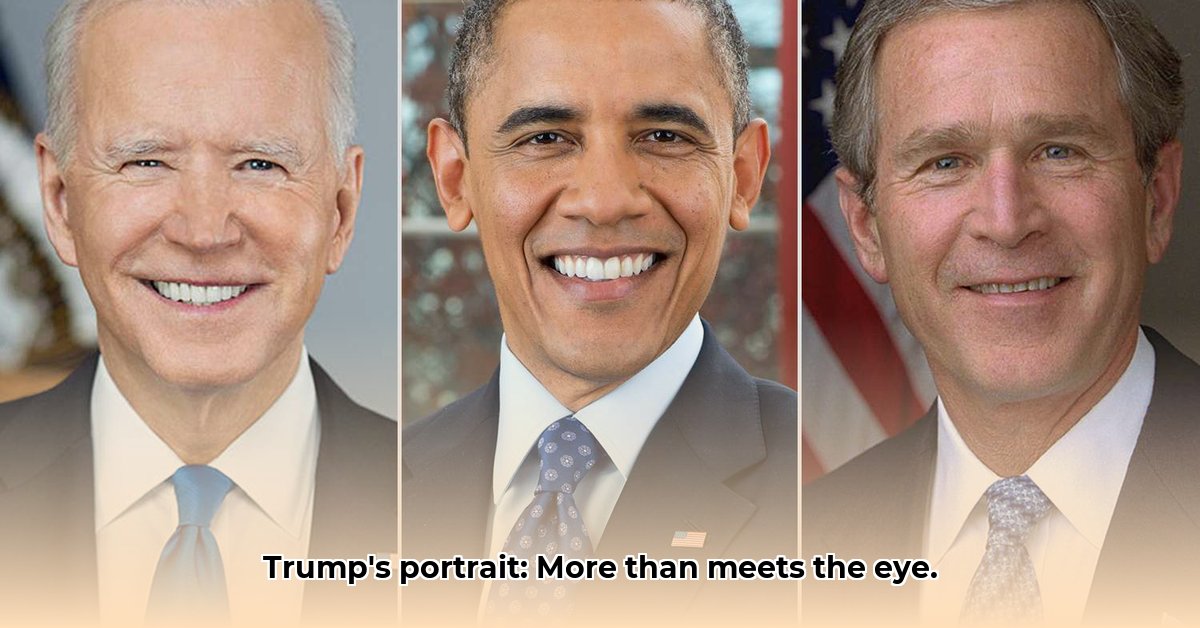
Trump Presidential Portrait Analysis: A Shifting Self-Image
The official portraits commissioned during Donald Trump's presidency offer a compelling case study in visual communication and political strategy. Beyond mere artistic choices, these images reveal a calculated evolution of his public persona, shifting from a relatively traditional presentation to a more controversial and assertive self-representation. Analyzing these changes provides key insights into Trump's political messaging and his efforts to shape public perception. For a look at potential future imagery, see more on Trump's 2025 portrait.
The 2017 Portrait: A Calculated Start
Trump's initial official portrait, released in 2017, presented a familiar image. The composition—a straightforward pose, simple background, and generally serious expression—echoed classic presidential portraits. This strategy aimed to project an image of competence and stability, a calculated effort to ease the nation into his unconventional presidency. It was a safe, if somewhat uninspired, approach, clearly contrasting with his later, more provocative choices. How effective was this strategy in establishing credibility with a broad electorate? How did this initial image contrast with his campaign persona?
The 2024 Portrait: Embracing the Controversy and the Mugshot
The stark contrast between the 2017 and subsequent portraits—particularly the 2024 iteration—is striking. The later image employs dramatic lighting, almost reminiscent of a film still, creating a mood that’s intense and potentially even menacing. This departure from established norms was undoubtedly deliberate, a carefully constructed message designed to resonate with a specific segment of the population. Many commentators have noted the visual parallels between this portrait and Trump's infamous mugshot. This intentional echo cleverly leverages existing public perceptions, both positive and negative, to reinforce his image as a strong, defiant figure. While this gamble might solidify support within his base, did it alienate potential swing voters? Was this a calculated risk to consolidate specific support?
Strategic Placement and the "Rewriting" of History
The placement of presidential portraits within the White House is far from inconsequential. The strategic positioning of Trump's portraits, for example, within the halls of power, is itself a symbolic statement. This subtle yet potent method seeks to redefine his place in presidential history, effectively—and potentially controversially—attempting to rewrite the narrative. These portraits are not simply static images; they are active participants in the ongoing political conversation. Furthermore, the commercialization of certain portraits, such as the reportedly $5,000 “Free America. Trump” artwork, further underscores the commodification of his image. How did this commercialization impact public perception and his broader political messaging?
Decoding the Visual Narrative: A Transformation in Self-Presentation
The dramatic shift between the 2017 and 2024 portraits underscores a conscious evolution in political branding. The initial portrait aimed for a relatable, almost statesmanlike appeal; the later portrayal emphasizes power, sometimes at the expense of approachability. Every aspect—the lighting, pose, and overall mood—was carefully chosen to evoke specific emotional responses. This transformation highlights how visual communication powerfully shapes political perceptions. What does this evolution suggest about Trump's evolving political strategy and his understanding of his own base? How effective was this strategy in achieving its intended goals?
Expert Analysis: Navigating the Interpretations
Analyzing Trump's portraits necessitates drawing from various disciplines. Art historians provide insight into the stylistic choices and historical context; political scientists analyze the strategic messaging and its target audience; and marketing experts assess the branding implications. While diverse interpretations exist, much remains subject to ongoing debate. The full impact of these images, and their strategic implications, will likely not be fully understood for decades.
Actionable Intelligence and Risk Assessment
The analysis of Trump's portraits offers actionable intelligence for various stakeholders:
| Stakeholder Group | Short-Term Implications | Long-Term Implications |
|---|---|---|
| Political Strategists | Campaign adjustments based on public reaction to portrait imagery. | Refining image management strategies for future campaigns. |
| Media Outlets | Analyzing symbolism, reporting on public discourse, opinion trends. | Tracking shifts in public perception of Trump and lasting historical impact. |
| Historians | Analyzing portraits within the broader context of presidential imagery. | Examining the portraits’ role in shaping historical narratives about Trump. |
| Art Critics | Evaluating artistic merit and symbolic meaning of each portrait. | Assessing the evolution of presidential portraiture as a political tool. |
Risk Assessment Matrix:
| Image Element | Risk Level | Mitigation Strategies |
|---|---|---|
| Dramatic Lighting | Medium | Diversification of photographic styles; seeking broader opinions. |
| Mugshot Inspiration | Medium | Careful management of associations; avoiding overt parallels. |
| Politicized Imagery | High | Close monitoring of public feedback; adaptation of image strategy. |
| Commercial Portrait Use | Medium | Tracking brand image implications; maintaining consistent messaging. |
| White House Placement | High | Anticipating and proactively addressing potential political backlash. |
How Trump's Evolving Presidential Portraits Strategically Shape Public Perception
Key Takeaways:
- Presidential portraits are powerful tools for shaping public image and political narratives.
- Trump's portraits reflect a dynamic strategy to project strength and a specific type of authority.
- Artistic choices, including pose, setting, and style, convey very specific, and often subtle, messages.
- The evolution of these portraits reveals shifts in Trump's self-presentation and attempts to control and manipulate public perception.
- Analyzing these portraits provides valuable insights into his political strategy, messaging, and broader understanding of visual communication.
The study of Donald Trump's presidential portraits extends beyond the realm of art appreciation. It offers a unique lens through which to examine the calculated use of visual communication in shaping public perception and building a political brand. The ongoing conversation surrounding these images continues to highlight the power of visual storytelling in the political landscape.